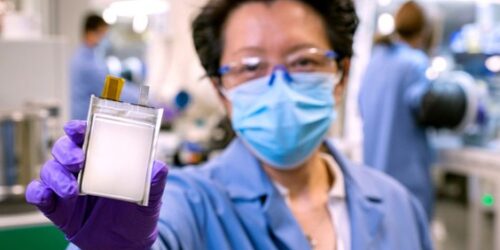A GM employee poses with an example of the company’s next-generation lithium metal batteries at GM Chemical and Materials Systems Lab in Warren, Michigan, U.S. September 9, 2020. PHOTO BY STEVE FECHT/GM /Windsor Star
Article content
On March 11, Canada’s Natural Resources Minister Seamus O’Regan released a list of 31 so-called critical minerals “essential to the economic and energy security” of Canada.
Being included on the list of 31 was based upon each mineral (or group of minerals as rare earth elements account for one listing) meeting at least one of three criteria.
Can Canada supply the mineral? Is the mineral essential to Canada’s security? Is it a mineral Canada needs the supply of which could be threatened by dominance of another country?
On March 10, Ontario’s Minister of Energy, Northern Development and Mines and Minister of Indigenous Affairs Greg Rickford announced that Ontario will develop a plan to promote discovery and extraction development of 30 critical minerals in this province.
All these critical minerals have one thing in common.
They are vital to production of numerous technological devices ranging from personal electronics to medical equipment and defence systems.
Many of critical minerals are components for batteries used in electric vehicles. As more countries shift towards lowering carbon output footprints to meet climate goals, the push is on to develop electric or battery systems where critical minerals play a crucial role.
According to the Canadian Institute of Mining industry magazine, Canada’s critical minerals include everything from Antimony and Bismuth to Cesium, Cobalt, Graphite, Lithium and a mess of relatively unusual minerals such as rare earth elements, Scandium, Tantalum and Tellurium.
And among very unusual but critical minerals not included on Canada’s list are Praseodymium and Neodymium, both of which figure in everything from metal alloys used in high-strength aircraft engines to permanent magnets used to miniaturize many electronic devices ranging from mobile phones to electronic musical instruments and carbon based lighting.
Two extremely significant minerals are cobalt and lithium.
Cobalt is used for everything from metal alloys to batteries the colouring of green glass and in radioactive form for treatment of cancer. Cobalt is a little known component of Lithium-ion batteries poised for clean green energy.
Lithium is used for heat-resistant glass, batteries including lithium-ion batteries and in some medical applications.
Clean energy and a move by automakers away from reliance upon fossil fuels means that demand for critical minerals will increase significantly by 2030.






